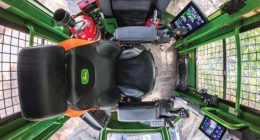Skip to content
Skip to main navigation
For Release: Monday, August 8, 2022
The New York State Department of Environmental Conservation (DEC) and the Finger Lakes Land Trust (FLLT) today announced the permanent protection of 234 acres at Casa Farms in the town of Niles, Cayuga County, with a conservation easement. The funding for this project came from a larger FLLT grant for $1.6 million from DEC's Water Quality Improvement Project Program (WQIP). The property features nearly 6,000 feet of frontage on Hooker Brook, which drains directly into Skaneateles Lake, the unfiltered drinking water supply for more than 200,000 people in the city of Syracuse.
"Protecting water quality is a top priority for DEC and our land trust partners throughout New York State," DEC Commissioner Basil Seggos said. "Our continued partnership with the Finger Lakes Land Trust on this and other projects in the region demonstrates our commitment to protecting drinking water sources and open space for residents and visitors in Central New York."
"This is great news for Skaneateles Lake," said FLLT Executive Director Andy Zepp. "The conservation easement will help protect water quality while providing for traditional agricultural use."
Conservation easements are voluntary legal agreements that permanently limit future land use in order to protect the land's conservation value. Lands subject to conservation easements remain in private ownership, on local tax rolls, and available for traditional uses such as farming and hunting. Through the establishment of this conservation easement, a buffer zone of natural vegetation along Hooker Brook was established to prevent potential contaminants from entering the drinking water supply while allowing for continued agricultural use on the rest of the property. Permanently protecting this property through conservation easement is a cost-effective way to protect Syracuse's drinking water source.
Casa Farms contains a mix of habitats including successional forests, shrublands, agricultural fields, and a hemlock-hardwood swamp. The property is located in the Skaneateles Highlands, a priority focus area of the FLLT that features the Trust's Bahar, High Vista, and Hinchcliff Family nature preserves. It is also in proximity to Bear Swamp State Forest and Carpenter Falls State Unique Area, owned and managed by DEC.
By working cooperatively with landowners and local communities, FLLT has protected more than 29,000 acres of the region's undeveloped lakeshore, rugged gorges, rolling forest, and scenic farmland. The FLLT owns and manages a network of more than 45 nature preserves that are open to the public and holds perpetual conservation easements on 171 properties that remain in private ownership. Additional information about the FLLT may be found at the Finger Lakes Land Trust website (leaves DEC website).
WQIP is a competitive, reimbursement grant program that funds projects that directly improve water quality or aquatic habitat, or protect a drinking water source. Under this grant program, DEC announced more than $60 million for 47 land acquisition projects to date. In addition to land acquisition projects for source water protection, WQIP grants are awarded for wastewater treatment improvement, non-agricultural nonpoint source abatement and control, salt storage, aquatic connectivity restoration, and marine district habitat restoration.
New York continues to increase investments in clean water infrastructure projects. Under the leadership of Governor Hochul, the 2022-23 Budget authorizes an additional $500 million in clean water infrastructure funding, bringing the State's total clean water investment to $4.5 billion since 2017. Consistent with the Governor's commitment to protecting New York's wetlands, the Budget also includes essential improvements to the State's wetlands protection program, safeguarding an estimated one million additional acres of unprotected wetlands habitat and helping New York adapt to increased flooding and severe storms fueled by climate change.
DEC and the State Department of Health, in collaboration with the Departments of Agriculture and Markets and State, created the Drinking Water Source Protection Program (DWSP2) to assist municipalities with proactively protecting their drinking water sources. The State is seeking communities to work with a technical assistance (TA) provider, free of charge, to develop and initiate implementation of their drinking water source protection program. DWSP2 plans not only protect public health but also protect water quality of both surface and groundwater across the state. To apply, visit the Drinking Water Source Protection Program (DWSP2) website and complete an online application. If you have any questions, reach out to the DWSP2 Team at source.water@dec.ny.gov.
Photo of Casa Farms courtesy of Ryan Walters
This page is available in other languages

